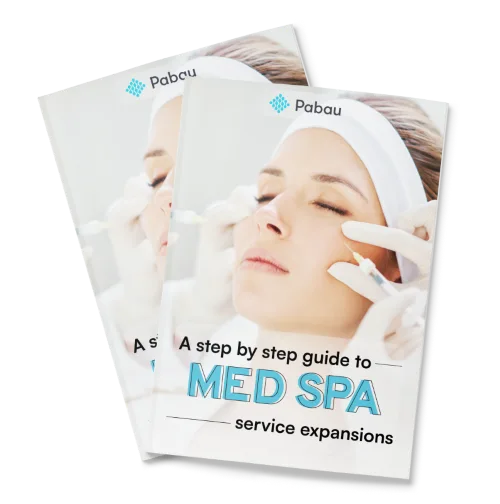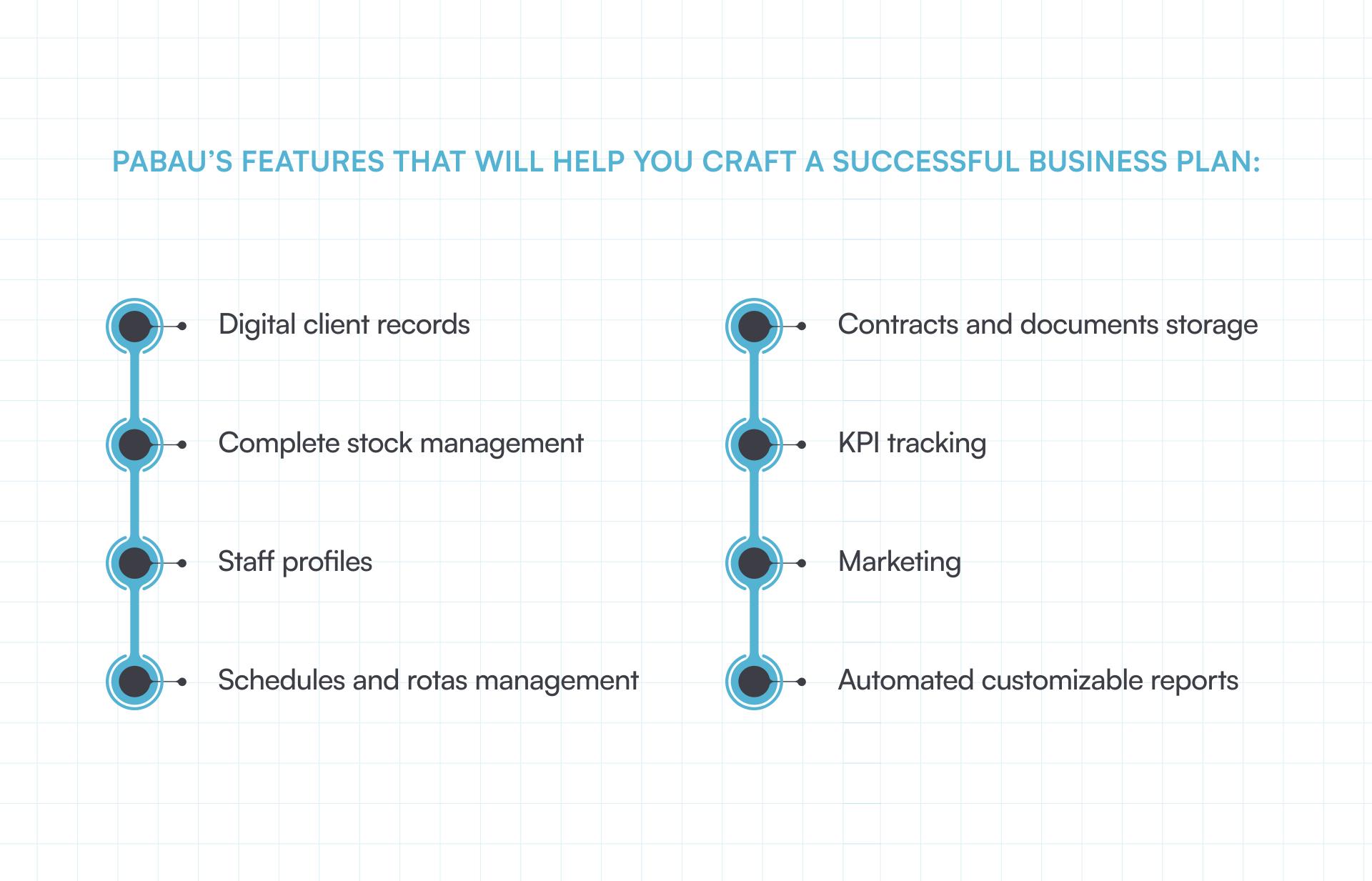Starting a business without a business plan is like traveling to another country without Google Maps.
Yes, after some missed turns and wasted time and gas, you’ll eventually get there, but you can’t take this risk with your business.
When starting an aesthetics clinic, a couple of missed turns can cost you time, money, and customers.
That’s why new business owners should start by crafting a well-researched plan before launching it, as it will:
- Provide insight into what resources you need
- Establish a clear timeline to reach your goals
- Offer a clear overview of your business’ progress
- Enable you to plan and predict potential risks
An all-in-one practice management software, such as Pabau, can help you with crafting and executing a successful business plan, as you can manage your team, plan your marketing strategy, create reports and analytics, and much more, all within the software.
Don’t know how to open an aesthetic clinic? Take a read at our guide.
Components of a successful business plan
Crafting a business plan is not an easy task but it’s a must, as businesses that develop business plans have 7% higher chances of growth compared to those without one.
It should include every step you’ll need to take and be aligned with your specific business goals.
Sound complicated? Don’t worry, we’ve prepared a detailed roadmap for you with the 10 most important parts of a business plan for medical aesthetics clinics.
1. Executive summary
The executive summary is the most important component of a business strategy. This summary should offer an overview of the whole business plan — a brief introduction to your clinic and its purpose, its unique selling point (USP), and its target market size.
Highlighting your financial projections, funding needs, and key milestones is also important.
While the executive summary is first on the list, it’s sometimes preferable to write it last so that you have a thorough knowledge of your plan and can properly explain it.
2. Company description
Second in the line, but preferably the first one to write, is the company description. Here, you should present a thorough overview of your business, including its values, mission, and objectives, the aesthetic services and products you’ll offer, and target clientele.
It’s also essential to include information on the industry your company intends to serve, highlighting any current trends and major competitors.
Additionally, you should also detail the expertise of you and your team within the industry, emphasizing what sets your company apart from competitors.
3. Market analysis
The market analysis or market research section of a business plan should identify and pinpoint the main audience your company is targeting, as well as where to reach them.
You should analyze the size and growth potential of the medical aesthetics market in your location and identify your main competitors, their strengths and weaknesses, and your competitive advantage.
In this section, you should cover:
- Places where your target clients spend their time. This can include specific social media platforms as well as physical locations
- The main pain points your target clients face
- The key needs of your target market and how your services address these needs
- Geographic and demographic information about your target clientele
- Information about their lifestyle
The purpose of this part is to clearly define your target audience so you can make smart decisions and predictions about how your products or services will benefit them.
4. Services offered
In this section, provide more information about the products and services your medi-aesthetics clinic or med spa will provide.
List the specific treatments and procedures your clinic will offer, and categorize them by body area or treatment type. Describe each service in detail, highlighting its benefits, risks, and the target client profile that will use them.
Additionally, include details about the products you’ll offer in your clinic, from which manufacturer you plan to order them, for which treatment they’ll be used, how long they can last, and how much they’ll cost.
In your business plan, it’s also important to mention any future plans for expanding your service portfolio, as it will give you insights when it’s the right time to incorporate them.
5. Marketing and sales strategy
This section of your business plan should include details about how you’ll attract new leads and clients and details about the offline and online marketing strategies you plan to execute.
You should also specify the channels you plan to use for your online marketing campaigns, like on which social media channels you plan to run your campaigns, how you’ll create an SEO-optimized website to promote your services, referral programs, etc.
Your business plan should also include:
- Your marketing strategy
- Sales tactics you’ll employ
- Your clinic’s unique selling points
- Reasons why your target clients should choose your clinic over competitors
- How you plan to reach your target audience
- Pricing strategies for your products and services
Specifying your budget for your marketing plan and sales needs, and any promotional offers you plan to implement is also crucial, as you’ll need to calculate it in the price of your services.
Read more to learn an effective 8-step marketing strategy for medi-aesthetic clinics.

6. Management team
Your team is the tool that will be driving your business success, so you should pick them wisely.
Here, you should present information about your company’s management and organizational strategy.
You should include details about your team of medical professionals, highlighting their qualifications, experience, and expertise, and explain how their skills and roles contribute to the clinic’s success.
For the information to be presented in a clear and understandable way you should consider including an organizational hierarchy chart for clarity — introducing your clinic’s leaders, roles, and responsibilities.
Additionally, you may include details about who will be responsible for human resources and the legal needs of your company, as well as information about the person handling any issues related to compliance, such as a HIPAA lead.
7. Operations plan
This part of your business plan should cover all the details about how you plan to operate your aesthetic practice.
Start by describing the physical aspects, including the location, layout, and setup of your clinic, as well as the equipment and technology infrastructure you’ll utilize to deliver services efficiently.
Next, delve into your patient intake and treatment processes, putting the emphasis on compliance with relevant regulations, to prioritize patient safety and satisfaction.
Additionally, detail your staffing plan, outlining the roles and responsibilities of employees, along with the training procedures to ensure they provide exceptional service.
Finally, include details on stock management and how you’ll make sure products in stock are not out of date. Broader operational aspects such as shipping logistics (if you plan to ship products to clients) or intellectual property patents can be included, and you can provide insights into your company’s growth plans, such as anticipated staffing or equipment requirements across various departments.
8. Financial projections
The idea of creating a financial plan may bring you out in a cold sweat.
But having it all written down makes it less less overwhelming. Design a thorough financial plan for the next three to five years. Include details about projected revenue, expenses (including equipment, staffing, marketing, etc.), balance sheets, and profitability statements.
For the initial operational year, it’s strategic to provide a detailed breakdown by quarter or even a month, and transition to an annual projection for the other 2-4 years.
To make your financial plan strong, make sure it covers the following components:
- Cash flow statement — crafting cash flow statements will give you insights into how much money you’ll need to launch and sustain business operations effectively. Consider factors such as expenses such as permits, licenses, and office essentials. Other things to include are business insurance, and salaries for physicians, nurses, and aestheticians.
- Balance sheets — your balance sheet should include details about assets and liabilities. The assets represent future profit-generating investments, while liabilities represent money that you owe and have to pay back to other external parties.
- Income statement — Also referred to as a profit and loss statement, this section should give you insights into whether your business became profitable.
Overall, the financial segment of your business blueprint outlines your revenue generation projections and it gives you insights if possible external funding is required.
9. Funding requirements
When it comes to funding, primary sources for a medical aesthetics business include personal savings, bank loans, credit cards, and investors.
However, only 48% of small businesses have their financing needs met. So that’s why those who plan to start a business turn to their banks for help.
Banks, though, typically require a thorough review of your business plan to ensure confidence in loan repayment, that’s why you’ll need reasonable financial projections and a professionally crafted plan.
Make sure you specify the amount of funding you need to launch and operate your clinic. Describe how you plan to use the funds and include financial statements and supporting documents to demonstrate your financial viability.
10. Risk management
For this final part of your business plan, you should strategically identify potential risks your clinic might face, such as competition, regulation changes, or economic downturns.
You should be aware of the current cost-of-living crisis. For example, 78% of consumers considering treatment believe that the cost of living crisis will have an impact over the next 12 months, so it’s important to factor ongoing circumstances into you business plans and document mitigation strategies for each risk, so you’re well-prepared.
From market shifts to regulatory updates, a well-prepared business plan demonstrates your readiness to adapt and overcome challenges in the medical aesthetics industry.
Automating the process in your aesthetics business will help you have more control over what’s going on in your clinic. After all, according to a survey, 57% of risk leaders will spend more on automating their processes so that they can monitor risks better.
Why Pabau is the ultimate resource for aesthetics clinics building business plans

Unfortunately, Pabau won’t serve you a detailed aesthetics business plan on a plate.
But, and hear us out, this is a good thing. A pre-made plan wouldn’t cater to your specific needs and could lead to failure. What Pabau will do, is be your “cookbook” that will guide you through the entire process of managing your business.
- Helps you stay compliant. Pabau securely stores digital records of all client information, facilitating easy management of patient treatment notes, communications, forms, photos, charts, and and ensuring compliance with healthcare regulations.
- List your services. Input all the services your new aesthetics clinic will offer, neatly organize them, and specify the time needed for each service. You can also create pre-care, aftercare, and service-specific forms to be sent automatically to your clients.
- Organize and manage your team. In the software, you’ll also be able to organize and manage your team — from assigning their roles, responsibilities, and services they can perform, as well as creating their shifts and rotas.
- Market your business. Pabau aids in the marketing section of your business plan as well, enabling you to create and schedule customizable marketing campaigns via SMS and email. It offers free pre-made templates but also allows you to design your own.
- Make data-led decisions. Reporting and analytics feature helps identify your clients’ favorite services and the most profitable ones, client retention rate, while also predicting future sales and trends and potential risks or trends.
Build your aesthetics business plan with Pabau
A well-crafted business plan is the key to launching a successful aesthetics business.
And Pabau will help you do it right.
- In-depth reporting features to track business performance
- Scheduling functionality to create a rota for your team
- Comprehensive client record-keeping features for compliance
- Built-in marketing capabilities to grow your business
All these useful features will help you craft a comprehensive executive summary for your aesthetics business and you’ll be ready to launch your business.
Find out about all the other aspects of your business Pabau can help you with by scheduling a demo with our team.




